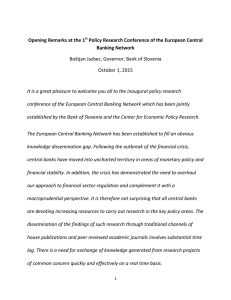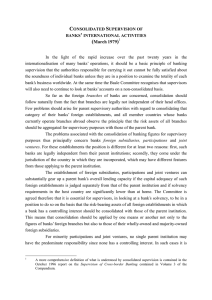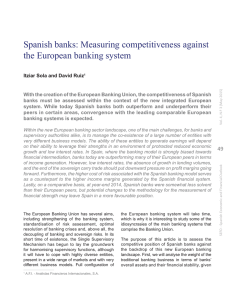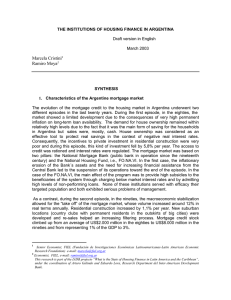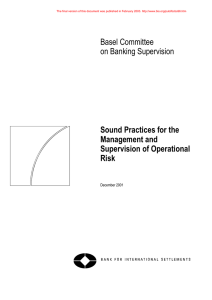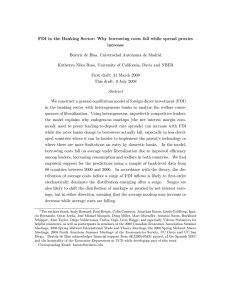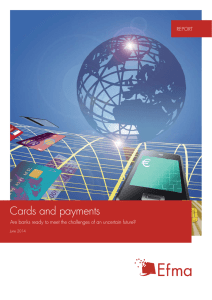Closing remarks
Anuncio
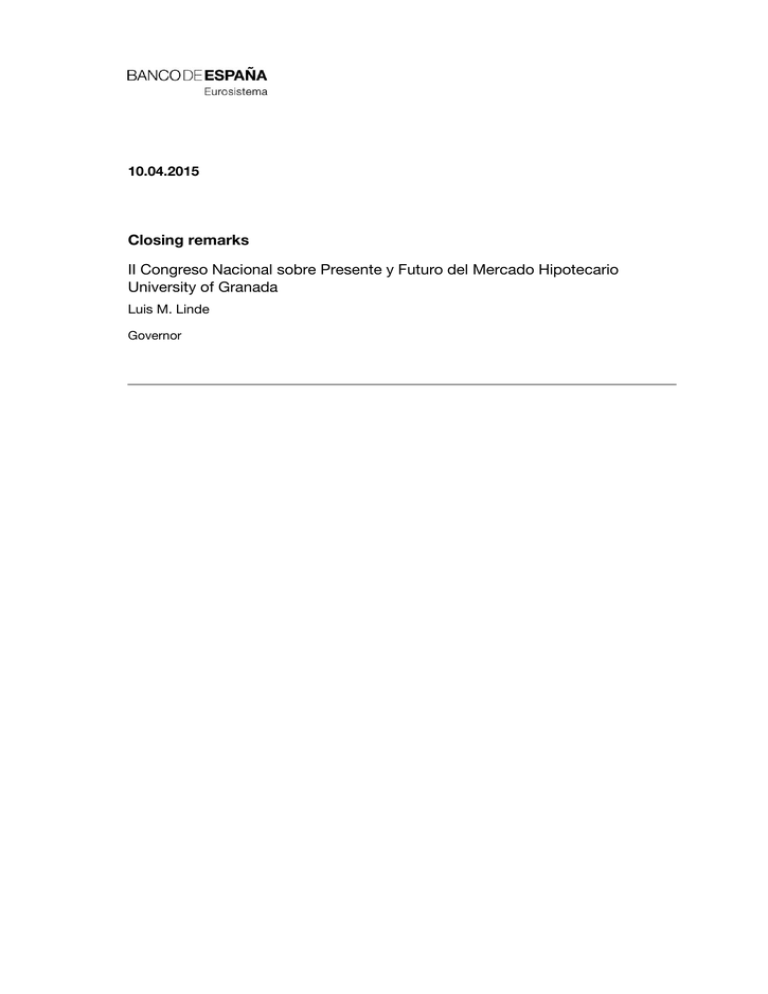
10.04.2015 Closing remarks II Congreso Nacional sobre Presente y Futuro del Mercado Hipotecario University of Granada Luis M. Linde Governor Let me begin by thanking Miguel Olmedo and Inmaculada Sánchez for inviting me to participate in the closing session of this II National Congress on “The Present and Future of the Mortgage Market. A Second Chance for Consumers and Entrepreneurs”. The relevance and scope of the matters addressed in this Congress more than justify a debate on the adaptation of the law and financial system regulations to social reality. A balance must be struck between respect for property rights, the efficient functioning of the financial system and protection of the socially excluded. A second chance The so-called “second chance” legislation seeks to provide individuals with the possibility of a “fresh start” after a financial, business or personal failure, without being indefinitely saddled with a debt which they may never be able to repay. Second-chance mechanisms are considered to be positive for debtors and also for society since, among other things, they are a deterrent to the black economy and promote an enterprise culture. Among the main changes approved, I would highlight Royal Decree-Law 1/2015 of 27 February 2015. This legislation, now in passage through Parliament as a draft law, includes initiatives in the area of insolvency law to strengthen the application of out-ofcourt payment settlements, and introduces a second-chance mechanism. In relation to the Code of Good Practices, the exclusion threshold, the application of so-called “floor clauses” and the calculation of the limit on the price of properties acquired to be able to avail oneself of the dation in payment envisaged in the code have all been reviewed. Lastly, the law on measures to strengthen the position of mortgage debtors provides for an extension of the moratorium on evictions in the cases of particular vulnerability identified in Law 1/2013. These improvements are in addition to those adopted as a result of the financial crisis. They are steps in the right direction which, given their significance, merit analysis and assessment. And, in this respect, I would like to voice two ideas. First, in this new setting it is essential that legislation should preserve the payment culture that has traditionally existed in the Spanish mortgage market. The erosion of this culture, as occurred in some euro area member countries under European Union bail-out programmes, would truly be most negative for the stability of the financial system. Second, the legislative amendments must strike an appropriate balance between the rights of creditors and those of debtors, especially the socially excluded, and I should like to highlight the advisability of concentrating efforts in the field of social policies: a country as economically, socially and institutionally developed as Spain has sufficient resources to face up to and resolve the most dramatic and unacceptable situations of exclusion and need without affecting financial stability in the process. All these issues have been duly discussed in this Congress, which is why I shall focus on the situation of our banking system and on our economic outlook. 3/7 Role and situation of Spanish banks I should first like to highlight the crucial importance of banks in resource allocation and their role of intermediation between those supplying and demanding financing. Mass access to owner-occupied housing would be almost inconceivable without their intermediation. Mortgage lending is a very important segment of the financial intermediation in which credit institutions engage. As at December 2014, mortgage loans for house purchase extended by credit institutions to households amounted to slightly over €541 billion, more than 40% of total bank lending. The number of outstanding mortgage loans for house purchase is at present 5.8 million, a large percentage of which (82%) are at floating rates, which has allowed for the transmission of the Eurosystem’s more accommodative monetary policy to household financing conditions. The quality of mortgage lending is crucial for the quality of our banks’ assets and, ultimately, for their solvency and stability. A deterioration in the quality of mortgage assets would affect the conditions on which financial institutions themselves are funded, since it might lead to a downgrading of mortgage market securities and that, in turn, might ultimately worsen borrowing conditions for households and firms. That said, Spanish banks are better placed today than one or two years ago to cope with the increase in the demand for credit that our economy will see with the recovery in activity and higher growth. This is due to three interrelated factors. First, the improvement in financial markets, in particular in the euro area. The monetary policy measures adopted by the European Central Bank and the reforms to the institutional framework of the euro have made a decisive contribution here. Second, the recovery in the Spanish economy, one component of which has been underpinned by the reforms already pushed through, which are contributing to correcting the imbalances built up during the upswing that ended in 2008. However, and this is the third factor, the favourable developments in the Spanish banking sector cannot be understood without considering the transformation it has undergone. This has involved the recapitalisation and restructuring of bank balance sheets; downsizing, entailing reductions in staff and in bank offices; and an overhaul of the savings bank sector, improving the corporate governance structure and resolving the situation whereby it was impossible for these institutions to tap the capital market for funds. These favourable developments are apparent in the behaviour of certain variables, which I shall briefly review. i. Non-performing loans Non-performing loans (NPLs) as a proportion of lending to the resident private sector in Spain have been falling since early 2014. On the preliminary data for February, the latest figures available, the NPL ratio for Spanish banks as a whole declined to 12.6%, the 4/7 lowest proportion for the past 18 months. This improved asset performance is the case both for households and for non-financial corporations. ii. Funding Spanish banks have improved their access to both retail and wholesale funding, and have significantly reduced their recourse to the liquidity provided by the Eurosystem. Nonetheless, recourse to the Eurosystem remains high given the limited activity on interbank markets. The trajectory of deposits in 2014 and the still-declining trend of credit have allowed the narrowing of banks’ loan-deposit gap to continue. The gap has narrowed by almost 40% since 2007. iii. Profitability The capacity of banks to generate profit reflects their resilience in the face of potential difficulties and, at the same time, their possibilities of developing banking business in a sustainable fashion. Figures for the first nine months of 2014 confirm that the sector has left behind the losses recorded in 2012. This better performance is underpinned by both the reduction in operating expenses and the lower provisioning needs derived from asset value adjustments. Net interest income, under downward pressure from limited business activity and low interest rates, increased moderately in 2014 compared with the same period in 2013. That said, this recovery is as yet modest and the downside pressures on the statement of income persist, meaning banks must persevere in containing their operating costs. iv. Solvency Attesting to Spanish banks’ solvency were the results of the stress test conducted before the start-up of the SSM, in 2014. As you will recall, no Spanish bank had to submit a capitalisation plan at the end of the year, even under the worst scenario considered. That is to say, under a hypothetical highly adverse macroeconomic scenario, all the participating Spanish banks evidenced solvency levels above the thresholds demanded by the European Central Bank and the European Banking Authority, the two institutions responsible for conducting the test. The latest available figures, for December 2014, confirm that the Spanish banking sector as a whole is operating with solvency levels that comfortably exceed the minimum regulatory levels required. Indeed, the top-quality common equity Tier 1 (CET1) ratio stands at 11.8% for the sector as a whole, well above the minimum regulatory level of 4.5%. The total capital ratio was 13.6%, also above the regulatory level of 8%. 5/7 The far-reaching transformation of the banking system and the enhanced position of Spanish banks will enable them to meet the foreseeable increase in the demand for credit as our economy picks up. Outlook for the Spanish economy To conclude, I wish to refer to our economic outlook within Monetary Union. On the information available for the first quarter of the year, Spanish GDP is expected to have increased at a quarter-on-quarter rate of 0.8%, making for a year-on-year rate of 2.5%, above the forecasts at the start of the year. This improved growth should be viewed as part of the overall picture for the euro area, which saw growth of 0.9% in 2014 compared with 0.4% in 2013. Both in the Spanish economy and in the euro area as a whole, this improvement in growth is being driven by consumption, the contribution of exports and the improvement in gross capital formation due, above all, to the pick-up in construction, although the decline in oil prices and the depreciation of the euro are also playing their part. Allow me to focus on two key elements here: employment and the change of tempo in the construction sector. The employment figures confirm this recovery in activity. In March, 1.4 million contracts were registered, 18.5% more than in March 2014, with significant growth in permanent and, in particular, in full-time contracts. Yet despite the historically positive figures in terms of the decline in the number of unemployed (over the past 12 months, registered unemployment saw the biggest year-onyear decline ever in the related time series), joblessness remains very high, with more than 4.4 million people out of work, reaffirming the need to persevere with the reforms and policies that have driven the improvements to date. It is also interesting to see that, during the fourth quarter of 2014, residential investment posted quarter-on-quarter growth of 0.4%, meaning it has increased for four consecutive quarters. These figures confirm the change in cycle and a moderately upward trajectory. In turn, open-market house prices, according to INE figures, are estimated to have increased by 0.3% in 2014, following six years of declines. The year-on-year rate in the fourth quarter was 1.8%, suggesting incipient – but growing – price rises, albeit with notable differences across regions and real estate market segments. Lastly, house-purchase figures for February announced yesterday also indicate a clear recovery, especially in second-hand housing. Underpinning the growth forecasts for our economy for 2015 and 2016 are the growth of private domestic demand and the strength of exports, along with the lower tax burden and the monetary stimulus measures adopted by the ECB, which are already having a significant impact on the cost of financing both for firms and households. Our current forecast – which is scheduled for review in June, September and December – is for Spanish GDP to grow by 2.8% over the course of 2015, and by 2.7% in 2016. 6/7 As to employment, the March figures reinforce our view that the unemployment rate should continue to fall, down to around 20% of the labour force by the fourth quarter of 2016. In Europe, the figures appear to support the view that the risks of deflation have been averted and that the economies of the Monetary Union and of the European Union as a whole are recovering and gaining momentum. If the Spanish economy is to benefit from these changes and likewise enjoy sustained higher growth, it will be essential to persevere with the reforms geared to adding market flexibility and boosting investment. Admittedly, however, the European and international financial context is unprecedented. The US exit from quantitative easing, with the interest rate rises that the markets expect, and the proliferation of negative interest rates on various financial and government debt markets, make for an unprecedented scenario that poses undoubted risks to financial stability with potentially highly volatile movements in financial asset prices. But if the risk of deflation in the euro area has finally been averted, and the US economic recovery continues apace, we may expect the financial markets to return to normal and yield curves to move back in step with normal, sustained economic growth. 7/7




